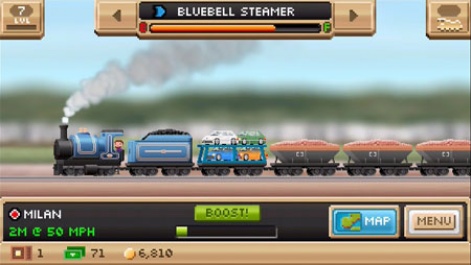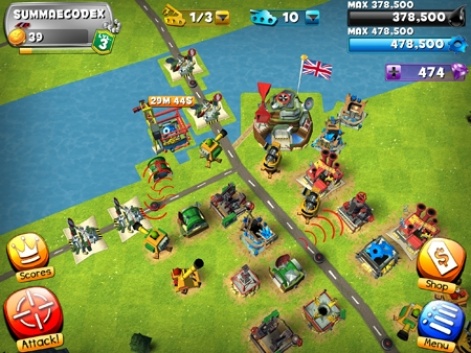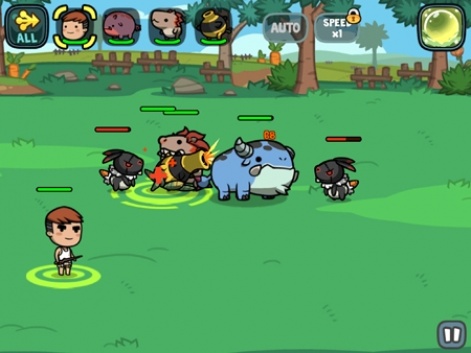Over the past couple of days, I've been looking back at 2013's F2P mobile games through the lens of my Monetizer analysis process.
In order to demonstrate trends, I've kept the analysis fairly general, but it's also interesting to point out some of the titles the process highlights as taking a different approach to industry standards.
So, on that basis, here are eight games released in 2013 that have very weird in-app purchase economies.
1. The 'Most Unmonetised Game' award: Pocket Trains
US developer NimbleBit is known for its pixel art style, but it also has a very laid-back approach to monetisation; something that was underlined in Pocket Trains.

Interestingly, the game has multiple hard currencies: Bux, Crates and Special Crates, but the most you can spend in any single IAP transaction is $9.99 for 2,000 Bux.
And when it comes to Crates, the maximum is $4.99, which is the lowest maximum of any game we analysed during 2013.
2. The 'Highest Average IAP Economy' award: Swords & Spells
German developer Xyrality made some strange decisions when it came to the IAP economy of Swords & Spells.
Instead of using the standard system of $4.99, $9.99, $19.99, $49.99 and $99.99 adopted by most games using a 5-band IAP economy, its IAP prices are $4.99, $10.99, $33.99, $54.99 and $99.99.
This gives it the highest 'average IAP economy' (see here for an explanation) of any game we analysed in 2013.
3. The 'Cunning Retail Experiment' award: Friendly Fire
The Red Robot Labs-published and Shortround Games-developed Friendly Fire is one of the few games in 2013 we found with IAPs priced at $39.99 and $49.99.

The reason for this decision is that the $39.99 IAP is heavily over-priced relative to the $49.99 IAP in terms of how much in-game currency you receive.
You get 100 Gems per dollar spent at $39.99 compared to 120 Gems per dollar spent at $49.99; hence encouraging players to spend that additional $10.
4. The 'Don't Spend $49.99' award: Angry Birds Go!
It's not clear why this should be the case, but in Angry Birds Go!, the $49.99 IAP is relatively over-priced compared to both the $19.99 and the $99.99 IAPs.
This could be a similar move to what we saw in Friendly Fire, but that seems unlikely as such pricing is more likely to get people to downsize their spending to $19.99 rather than double up to $99.99.
As it stands, however, you get the same number of gems per dollar spent if you take the $9.99 IAP as if you spend $49.99, which is a rough deal if you spend $49.99.
5. The 'Hardcore Virtual Currency Retailing' award: Team Monster
As we all know, retailing is as much about psychology as anything else. That's why during 2013, there's been a growing consensus in terms of the price points for IAPs, and the units of in-game currency you get for your money.
Two games stand out, however, as going against the grain. Whereas many games will swap one dollar for around 100 in-game currency units, Warner Bros.' Batman: Arkham Origins gives you only 11 WayneTech Points per dollar spent if you buy the $99.99 IAP. And if you spend $2.99, you only get 5 WayneTech Points per dollar spent.
However, the game has two hard currencies, so it balances this hardcore attitude with the other currency, Upgrade Points. If you spend $99.99 on these, you'll get 11,001 points for each dollar spent. That's a massive contrast.

The DeNA-published and Dancing Anchovy-developed Team Monster only has one hard currency, though, and that means it sneaks the award for the most hardcore virtual currency retailing award of 2013.
Spend $99.99 on its Cash and you'll get just 11 units of Cash per dollar spent. That's just harsh (psychologically).
6. The 'Single White Female' award: Fast & Furious 6: The Game
Given Kabam's Fast & Furious 6: The Game is in the same genre as NaturalMotion's CSR Racing, it was no surprise that Kabam considered what aspects of the 2012-released game it would innovate on (drift racing), and which it would adopt (the IAP economy).

This can be clearly seen as we only discovered four games that use the $59.99 IAP price point. Two are in the CSR franchise, one is Codemasters' Boom! Tanks (aka CSR Racing with Tanks, and one is Fast & Furious 6: The Game.
Unlike Boom! Tanks, however, Fast & Furious 6: The Game uses pretty much exactly the same virtual currency retailing system as the CSR games right down to the in-game currency units per each IAP.
7. The 'Pack The Mid-Range' award: Plants vs. Zombies 2
The EA/PopCap sequel was controversial for its move to free-to-play, but more significant in terms of its IAP economy was the fact that Plants vs. Zombies 2 was the only game we analysed in 2013 with an 8-band IAP system.
In contrast, most other games in 2013 used a 5- or 6-band system. The additional price points were used in Plants vs. Zombies 2 to pack out the mid-range prices, with IAPs available at $29.99, $39.99 and $49.99.
8. The 'Getting It All Wrong' award: Redacted
Perhaps our most controversial award is for the game that launched with such an unbalanced IAP system that its $0.99 purchase was the most generous of all in terms of the units of currency you received per dollar spent.
Sadly, however, we forgot to take a screenshot as proof, and since our original analysis, it appears an update has fixed the problem. Yet, such is the opprobrium that would be heaped on a company that made such a fundamental error, without that proof it's not appropriate to name and shame.
Next time, we won't be so stupid.





















